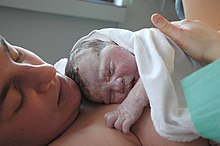Live birth (human)

In human reproduction, a live birth occurs when a fetus, whatever its gestational age, exits the maternal body and subsequently shows any sign of life, such as voluntary movement, heartbeat, or pulsation of the umbilical cord, for however brief a time and regardless of whether the umbilical cord or placenta are intact.[1]
This definition of the term "live birth" was created by the World Health Organization in 1950 and is chiefly used for public health and statistical purposes. Whether the birth is vaginal or by Caesarean section, and whether the neonate is ultimately viable, is not relevant to this statistical definition. However, the term "live birth" was in common use long before 1950.[2]
In the United States, the term "born alive" is defined by federal statute[3] known as the born alive rule. Live births are recorded on a U.S. Standard Certificate of Live Birth, also known as a birth certificate.[4] The United States recorded 3.95 million live births in 2016.[5]
Some women have chosen to release online videos of the live births of their infants.[6][7][8] There is one case report of a woman having a live birth derived from a frozen embryo obtained before she began cancer treatment.[9]
Not all pregnancies result in live births. A woman may choose to end her pregnancy by abortion. Miscarriage, also known as spontaneous abortion and pregnancy loss, is the natural death of an embryo or fetus before it is able to survive independently.[10][11] Some use the cutoff of 20 weeks of gestation, after which fetal death is known as a stillbirth.[12] The death of the fetus or neonate at the end of the pregnancy, during labour and delivery, or just after birth is counted as perinatal mortality.
See also[]
References[]
- ^ World Health Organization. International statistical classification of diseases and related health problems. Tenth Revision. Vol 2. Geneva, Switzerland: World Health Organization, 1993:129.
- ^ Search full view Google Books for "live birth" prior to the year 1950.
- ^ "1 U.S. Code § 8 - "Person", "human being", "child", and "individual" as including born-alive infant". LII / Legal Information Institute. Retrieved 22 August 2017.
- ^ "NVSS - Revisions of the U.S. Standard Certificates and Reports". www.cdc.gov. 2017-08-30. Retrieved 2018-10-23.
- ^ Martin JA, Hamilton BE, Osterman MJK, Driscoll AK, Drake P. Births: Final data for 2016. National Vital Statistics Reports; vol 67 no 1. Hyattsville, MD: National Center for Health Statistics. 2018.[1]
- ^ "This woman is livestreaming the birth of her child on Facebook". 9 February 2017. Retrieved 22 August 2017.
- ^ Spangler, Todd (24 June 2016). "TLC Broadcasts Live Birth on Facebook". Retrieved 22 August 2017.
- ^ Woolf, Nicky (17 May 2016). "The miracle of live: man uses Facebook Live to stream his child's birth". Retrieved 22 August 2017 – via The Guardian.
- ^ Yang, Dunsong; Brown, Samuel E.; Nguyen, Kevin; Reddy, Vijay; Brubaker, Cindy; Winslow, Kevin L. (1 June 2007). "Live birth after the transfer of human embryos developed from cryopreserved oocytes harvested before cancer treatment". Fertility and Sterility. 87 (6): 1469.e1–4. doi:10.1016/j.fertnstert.2006.07.1546. PMID 17418837.
- ^ The Johns Hopkins Manual of Gynecology and Obstetrics (4 ed.). Lippincott Williams & Wilkins. 2012. pp. 438–439. ISBN 9781451148015. Archived from the original on September 10, 2017.
- ^ "What is pregnancy loss/miscarriage?". www.nichd.nih.gov/. July 15, 2013. Archived from the original on April 2, 2015. Retrieved March 14, 2015.
- ^ "Stillbirth: Overview". NICHD. September 23, 2014. Archived from the original on October 5, 2016. Retrieved October 4, 2016.
- Obstetrics
- Demography
- Midwifery
- Infancy
- Reproduction in mammals
- Childbirth